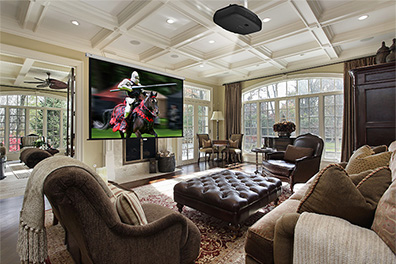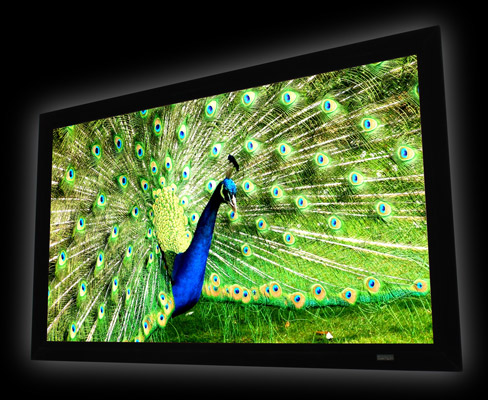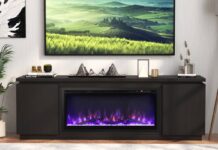 There was a time the word “projector” recalled images of a weak beam with dust flies buzzing through the cylinder of light. Fortunately, projectors today are vastly improved. They’re insanely bright, can give you a huge image size, they’re quiet, and versatile. If you haven’t considered getting one instead of a TV, it’s time for a look, particularly since it’s Home Theatre Month.
There was a time the word “projector” recalled images of a weak beam with dust flies buzzing through the cylinder of light. Fortunately, projectors today are vastly improved. They’re insanely bright, can give you a huge image size, they’re quiet, and versatile. If you haven’t considered getting one instead of a TV, it’s time for a look, particularly since it’s Home Theatre Month.
Projector Basics: Phenomenally bright image
Projectors measure brightness in lumens: basically a number that tells you how bright the image will be, and thus how big you can project it, even with some ambient light entering the room. Most projectors now use about 2300 lumens minimum. That is bright enough to create a 10-14 foot image clearly, even with some light coming in. People are also using their projectors outdoors in good weather, having movie night under the stars, or taking in a ball game in the backyard. Today’s projectors can stand up to that kind of ambient light competition.
Projector Basics: 3 types
You’ll come across three types of projectors: LCD, DLP, and LCOS. I’ll simplify each:
- LCD is basically the same technology used in flat-panel TVs, except in this case, they beam the light through the set of liquid crystals, rather than bouncing light off it. This Epson is one example of that technology.
- DLP, or Digital Light Processing, uses millions of tiny mirrors, or “digital micromirrors” to reflect light and beam your image. This is the type of projector most often found in movie theatres.
- LCOS projectors are the third type, with the acronym standing for “liquid crystal on silicon”. LCOS is basically a combination of LCD and DLP technology.
Projector Basics: They’re kinda smart
Projectors are no longer just for slides and power point presentations. They’re TVs in a much smaller box. You can hook your computer up to a projector and stream TV, photos, home videos and more. You can also connect it to a device like Google Chromecast, so you can play online shows or movies right to the projector from your phone.
Projector Basics: It can be like being in a movie theater
While we all laud our flat screen TVs, we forget that when we go to the movies, they’re still using projectors to beam all that big budget hollywood goodness up there. Mind you, those projectors cost more than your car, but at its core it’s the same technology that’s now available to you at home. So if you’re looking for that big screen feeling in your basement or media room, projectors are the way Hollywood still prefers to go. These projectors as I noted above are DLP, and they’re often available for home use.
Projector Basics: They’re the ninjas of home theatre
Sure, TVs come in sizes from massive to ginormous now. But they’re still heavy, and big, and take up a lot of wall or console space. Projectors are the ninjas of home theatre. They can hide out where you can’t see them, and then when it’s time; BAM, there they are, at the ready. Even today’s most powerful projectors are really only the size of a coffee maker, not to mention they come in white, so they blend in a lot better.
Projector Basics: Don’t forget you need a screen!
 If you’re clever, and want to continue the theme of your home theatre system as a band of ninjas, you don’t even need a screen. A white or even beige wall is the perfect canvas. But the purists will want one, and there are numerous screen options, both pull-down, and automatically retractible. The projector can be hidden in an adjacent cabinet, or hooked to the ceiling.
If you’re clever, and want to continue the theme of your home theatre system as a band of ninjas, you don’t even need a screen. A white or even beige wall is the perfect canvas. But the purists will want one, and there are numerous screen options, both pull-down, and automatically retractible. The projector can be hidden in an adjacent cabinet, or hooked to the ceiling.
Depending how much work you want to do with it, or how frequently you might need to hide a screen, you can select a motorized version, like this EluneVision matte, or “cinema white” screen which uses washable fabric. When not in use, it retracts into the ceiling, into a casing designed to lie flush with your ceiling. The motor drops it quickly and quietly, and it comes with a remote control and a wall-mountable control panel. It also comes (bonus!) fully assembled and ready to install.
More the retro do-it-yourself type? A manual screen works just as well. Manual screens usually have a self-locking mechanism that allows the screen to be unrolled to almost any position, rather than only a handful of presets.
To sum it all up, projectors are versatile, small, quiet and can provide an amazing viewing experience. After all, if you like going to the movies, you’re seeing some of the finest projectors in action, and that’s the type of experience today’s projectors can give you at home. It’s definitely an option to consider if you’re upgrading a media or TV room.




Something that I wondered… what’s the difference between a data projector and a home theatre projector besides the price? I can’t tell the difference watching video on a data projector.
From what I’ve read, there’s more contrast ratio in home versions. Also, data projectors are mainly for computer use, while HT projectors can do both coputers and video sources. Also, data projectors are often 4×3 aspect ratio (for business applications like Powerpoint ) while Multimedia are usually 16×9.
When it comes to projectors, the “basics” are an important part of the overall picture.
As you mentioned @ErinLYYC when it comes to a screen ” the purists will want one “. I beg to differ that ” A white or even beige wall is the perfect canvas.” While it may produce an “acceptable” image, it will not allow for the true potential of the projector.
The screen is the canvas for the painting, and the type of material is dependant on ambiant light among other issues of the room,to provide a proper picture. Any wall, grey or otherwise will produce a “faded” image in comparison to an appropriate screen, white,grey, or beaded. If you skimp on the quality of the canvas, don’t be disappointed by the lackluster result of the colours or lack of depth of the image.
Also, when it comes to screens, as convenient as electric or manual roll up screens may be, I urge my clients to insist on “tab tensioned” screens, to avoid curled edges and rippled screens from shrunken stitching, in our humid country. Forced air heating, can also cause focus problems with pull down screens, so screen locations also need to be considered. Another point is in-wall speakers situations, may require a need for perforated screens, fixed or motorized.
I love this line Elico: “The screen is the canvas for the painting”. It’s so true. I think if you’re going to make the commitment to switch, go all the way. But for someone on a fixed budget who’s taking it one step at a time, a wall will work temporarily, until you can afford the best possible canvas.
After all, even an Andy Warhol doodle on a dinner napkin canvas can still fetch a pretty penny. http://www.stuff.co.nz/entertainment/arts/63901608/andy-warhols-napkin-sells-for-15000
http://www.stuff.co.nz/entertainment/arts/63901608/andy-warhols-napkin-sells-for-15000
Comments are closed.